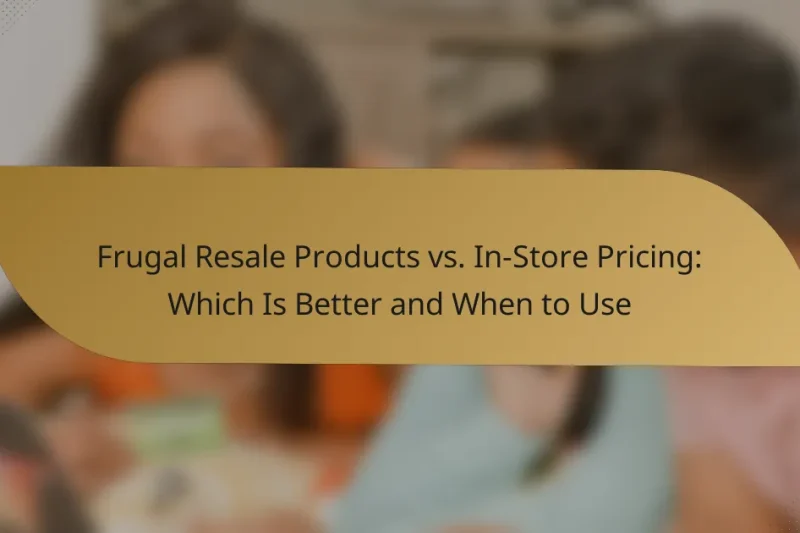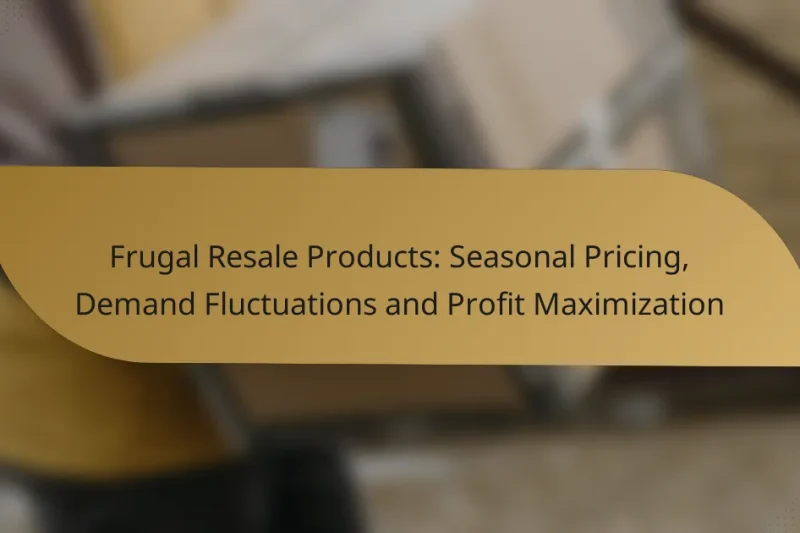In the competitive landscape of luxury resale, pricing frugal products demands a careful balance of perceived … Frugal Resale Products: High-End Pricing, Luxury Market and Buyer ExpectationsRead more
Frugal Resale Products: Effective Pricing Strategies
Effective pricing strategies for frugal resale products are essential for maximizing profits while appealing to budget-conscious consumers. By analyzing competitors and understanding customer perceptions, sellers can set prices that not only ensure profitability but also attract buyers in a competitive market.
Frugal Resale Products: Competitor Analysis, Pricing Models and Market Positioning
In the competitive landscape of frugal resale products, sellers must identify high-demand items that balance affordability … Frugal Resale Products: Competitor Analysis, Pricing Models and Market PositioningRead more
Frugal Resale Products: Market Trends, Pricing Strategies and Consumer Demand
The market for frugal resale products is experiencing a notable transformation, driven by the rise of … Frugal Resale Products: Market Trends, Pricing Strategies and Consumer DemandRead more
Frugal Resale Products: Profit Margin, Pricing Techniques and Market Insights
In the competitive world of frugal resale products, maximizing profit margins hinges on a deep understanding … Frugal Resale Products: Profit Margin, Pricing Techniques and Market InsightsRead more
Frugal Resale Products: Discount Strategies, Profit Preservation and Customer Retention
In the competitive world of frugal resale products, implementing strategic discount tactics is crucial for attracting … Frugal Resale Products: Discount Strategies, Profit Preservation and Customer RetentionRead more
Frugal Resale Products vs. In-Store Pricing: Which Is Better and When to Use
When it comes to shopping, frugal resale products present a compelling alternative to traditional in-store pricing, … Frugal Resale Products vs. In-Store Pricing: Which Is Better and When to UseRead more
Frugal Resale Products: Seasonal Pricing, Demand Fluctuations and Profit Maximization
In the competitive world of frugal resale products, maximizing profits requires a keen understanding of seasonal … Frugal Resale Products: Seasonal Pricing, Demand Fluctuations and Profit MaximizationRead more
What are effective pricing strategies for frugal resale products?
Effective pricing strategies for frugal resale products focus on maximizing profit while remaining attractive to cost-conscious consumers. These strategies involve analyzing competitors, understanding customer value perceptions, and adapting pricing dynamically based on market conditions.
Competitive pricing analysis
Competitive pricing analysis involves researching the prices of similar products offered by competitors. This strategy helps you position your products within the market by setting prices that are comparable or slightly lower than those of rivals.
To conduct a competitive pricing analysis, gather data on at least five similar products, noting their prices and features. Aim to set your prices within a range that reflects your product’s quality while still appealing to budget-minded shoppers.
Value-based pricing
Value-based pricing focuses on setting prices based on the perceived value to the customer rather than solely on costs. This approach requires understanding what features or benefits customers value most and how much they are willing to pay for them.
To implement value-based pricing, conduct surveys or interviews to gauge customer preferences. For example, if your product offers unique features that save time or enhance convenience, you might price it higher than competitors who do not offer those benefits.
Dynamic pricing models
Dynamic pricing models allow you to adjust prices in real-time based on market demand, competition, and inventory levels. This strategy can help maximize revenue during peak demand periods and clear out excess inventory during slower times.
Consider using software tools that analyze market conditions and automatically adjust prices. For instance, if a popular item is running low in stock, you might increase its price slightly to capitalize on urgency while still being mindful of customer expectations.
Bundle pricing strategies
Bundle pricing strategies involve offering multiple products together at a reduced price compared to purchasing each item separately. This approach can increase the perceived value and encourage customers to buy more items.
For example, if you sell kitchen gadgets, consider bundling a knife set with a cutting board at a price lower than buying each item individually. This not only boosts sales but also enhances customer satisfaction by providing a complete solution.
Psychological pricing techniques
Psychological pricing techniques leverage consumer behavior to influence purchasing decisions. Common methods include pricing items just below a round number, such as $19.99 instead of $20, to create the perception of a better deal.
Additionally, consider using charm pricing, where prices end in .99 or .95, as studies show that consumers often perceive these prices as significantly lower. Implementing these techniques can help improve sales without drastically affecting profit margins.
How to determine the right price for resale products?
Determining the right price for resale products involves evaluating costs, market conditions, and customer expectations. A well-set price ensures profitability while remaining attractive to buyers.
Cost-plus pricing method
The cost-plus pricing method involves calculating the total cost of acquiring or producing a product and then adding a markup percentage to ensure profit. For example, if a product costs $50 to acquire and you apply a 30% markup, the selling price would be $65.
This method is straightforward but may not always reflect market demand. It’s essential to balance your markup with competitive pricing to avoid losing potential sales.
Market research insights
Conducting market research helps identify how similar products are priced in your target market. This can include analyzing competitors’ prices and understanding customer willingness to pay. For instance, if similar items are priced between $70 and $90, positioning your product within this range can enhance its attractiveness.
Utilizing tools like surveys or online analytics can provide valuable insights into pricing strategies. Regularly updating your research ensures you remain competitive as market conditions change.
Customer feedback incorporation
Incorporating customer feedback into your pricing strategy can significantly enhance your approach. Engaging with customers through surveys or reviews can reveal their perceptions of value and price sensitivity. For example, if customers express that a product feels overpriced, it may be wise to adjust your pricing accordingly.
Additionally, testing different price points and gathering feedback can help identify the optimal price that maximizes both sales and customer satisfaction. Keep an eye on sales trends to see how pricing changes impact customer behavior.
What are common mistakes in pricing frugal resale products?
Common mistakes in pricing frugal resale products include failing to consider competitor prices, overestimating perceived value, and underestimating shipping costs. These errors can lead to pricing that either deters buyers or results in losses.
Ignoring competitor prices
Ignoring competitor prices can significantly affect your pricing strategy. If your prices are higher than similar products, potential buyers may choose alternatives, while prices that are too low can raise suspicions about quality.
To avoid this pitfall, regularly research competitors’ pricing for similar items. Aim to position your products competitively, perhaps within a range of 5-15% of their prices, depending on your unique selling points.
Overpricing based on perceived value
Overpricing based on perceived value can alienate customers. Just because an item seems valuable to you does not mean buyers will agree, especially in a frugal market where cost sensitivity is high.
To set appropriate prices, consider the actual market demand and the condition of the item. Use tools like online marketplaces to gauge what similar items are selling for, and adjust your prices accordingly to avoid losing sales.
Underestimating shipping costs
Underestimating shipping costs can erode your profit margins. Many sellers overlook the total expense of shipping, including packaging materials and potential returns, which can add up quickly.
To mitigate this issue, calculate shipping costs accurately before pricing your products. Consider using flat-rate shipping options or incorporating shipping fees into the product price to provide clarity to buyers while maintaining profitability.
How to leverage online platforms for pricing?
Leveraging online platforms for pricing involves utilizing their built-in tools and strategies to set competitive prices for your resale products. Understanding the dynamics of each platform can help you attract buyers while maximizing your profit margins.
Using eBay’s pricing tools
eBay offers various pricing tools that can help you determine the best price for your items. The “Best Offer” feature allows buyers to negotiate, which can lead to quicker sales. Additionally, using eBay’s pricing suggestions based on similar listings can provide a solid starting point.
Consider setting your starting bid low to attract more bidders, while also ensuring your reserve price covers your minimum acceptable profit. Regularly check completed listings to gauge what similar items have sold for, which can inform your pricing strategy.
Amazon pricing strategies
On Amazon, competitive pricing is crucial due to the vast number of sellers. Utilizing the “Automated Pricing” tool can help you adjust your prices dynamically based on competitors’ actions. This tool can keep your prices competitive without constant manual adjustments.
Consider using psychological pricing strategies, such as pricing items just below a round number (e.g., $19.99 instead of $20). Additionally, monitor your seller rating and customer feedback, as these can influence your pricing power and sales velocity.
Facebook Marketplace pricing tips
When pricing items on Facebook Marketplace, consider the local market demand and the condition of your products. Research similar listings in your area to set a competitive price. Since Facebook Marketplace allows for direct communication, you can negotiate prices easily with potential buyers.
Be transparent about your pricing by highlighting the value of your items and being open to reasonable offers. Avoid overpricing, as this can deter buyers; a good rule of thumb is to price items 10-20% lower than similar listings to attract interest.
What factors influence pricing decisions in e-commerce?
Pricing decisions in e-commerce are influenced by various factors including market demand, competition, and cost of goods. Understanding these elements helps sellers set effective prices that attract customers while ensuring profitability.
Market demand fluctuations
Market demand fluctuations refer to the changes in consumer interest and purchasing behavior over time. These fluctuations can be driven by seasonal trends, economic conditions, or shifts in consumer preferences.
To effectively respond to market demand, sellers should monitor sales data and market trends regularly. For instance, during holiday seasons, demand for certain products may surge, allowing for higher pricing, while off-peak times might require discounts to stimulate sales.
Consider using dynamic pricing strategies that adjust prices based on real-time demand. Tools and software are available that can automate this process, ensuring prices remain competitive and aligned with current market conditions.






